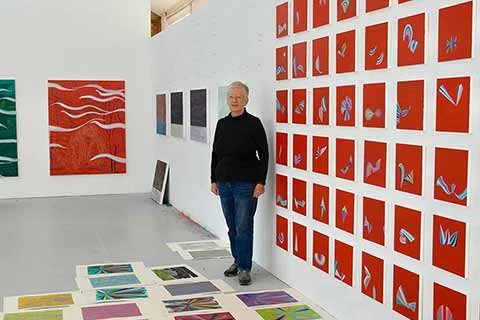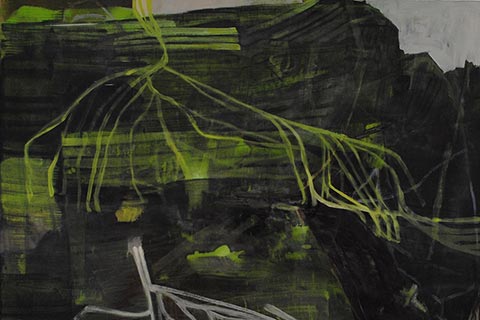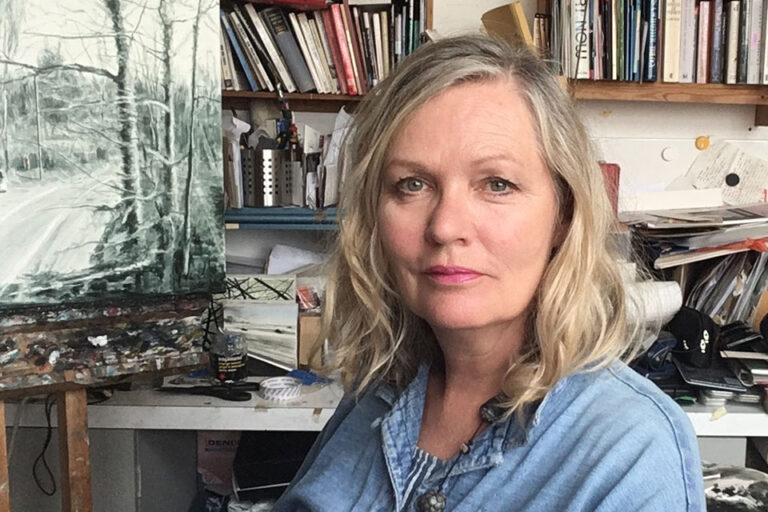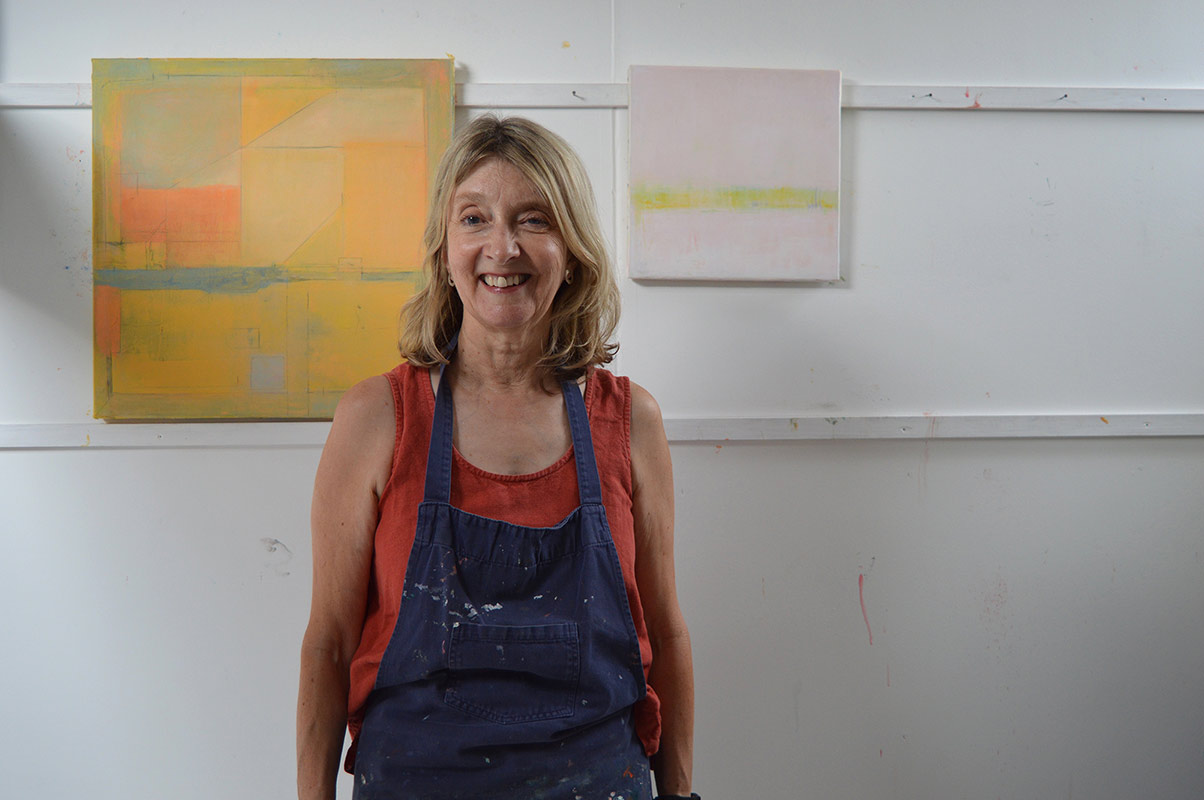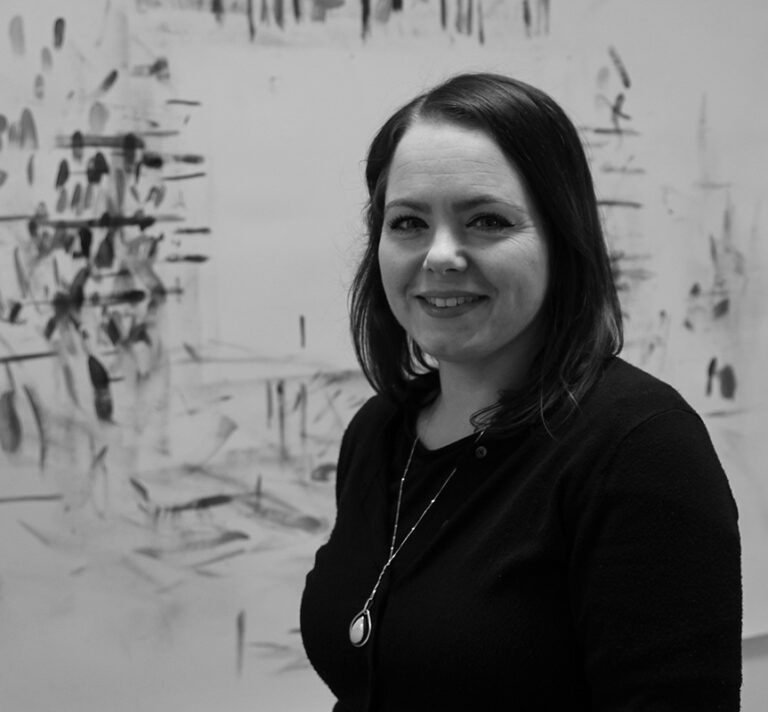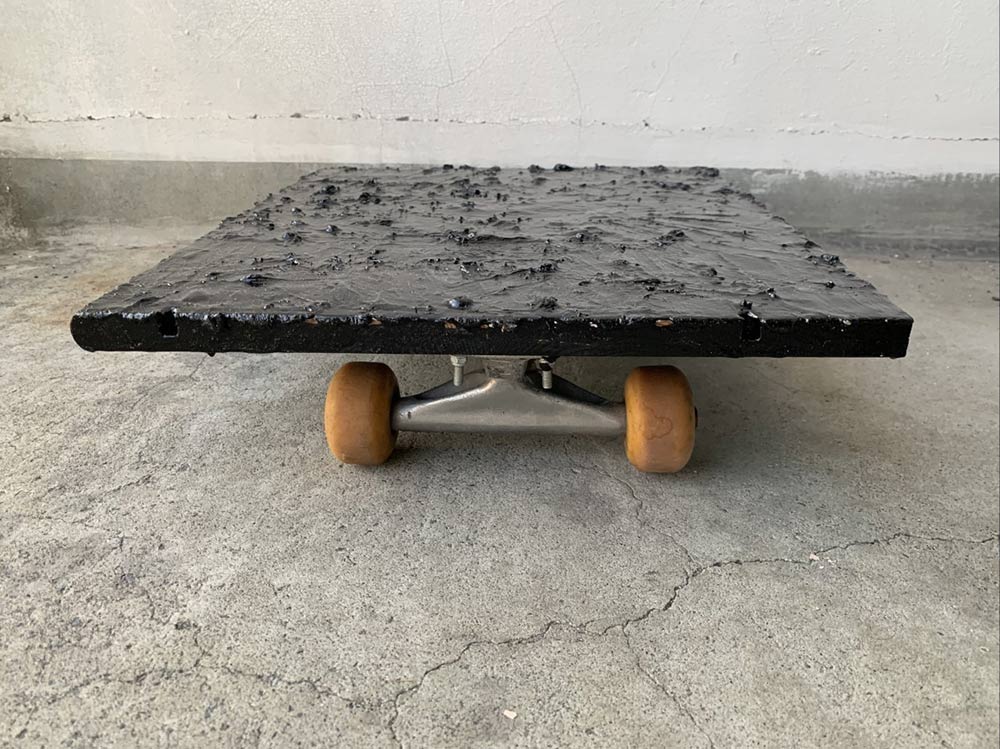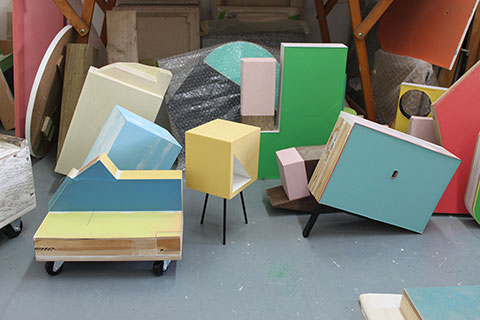Freya Purdue: Artist of the Month
Freya Purdue Contemporary British Painting artist of the month November 2020
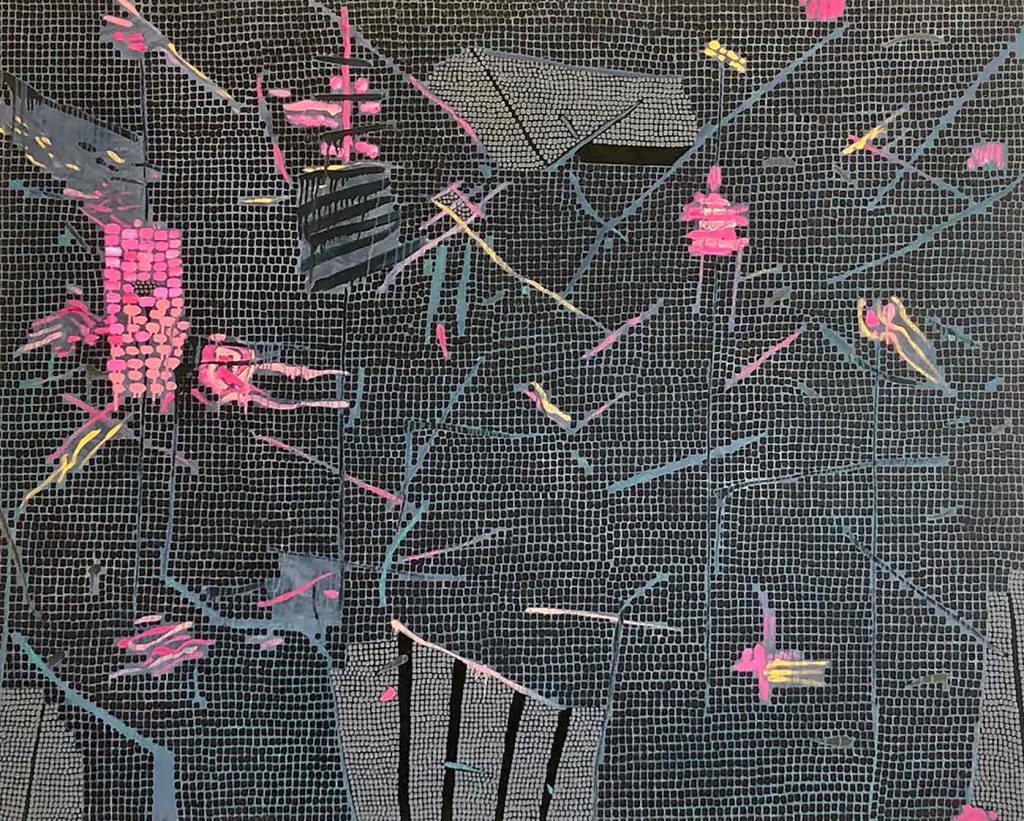
My paintings inhabit the border between abstraction and figuration and have their basis in exploration through seeing, experience and research around the ideas I am currently working with.
I draw on a wide range of sources from the most obvious classical themes in painting to the subtlety of philosophical and mystical thought…Each group of work is a new journey and each painting a new kind of sensitivity and living energy to be explored and realised. Through the process of constant reviewing and reflection, the paintings are worked towards the realisation of a sense of connectedness that links them with contemporary life, cultural histories, artists, practices and symbologies. – Freya Purdue
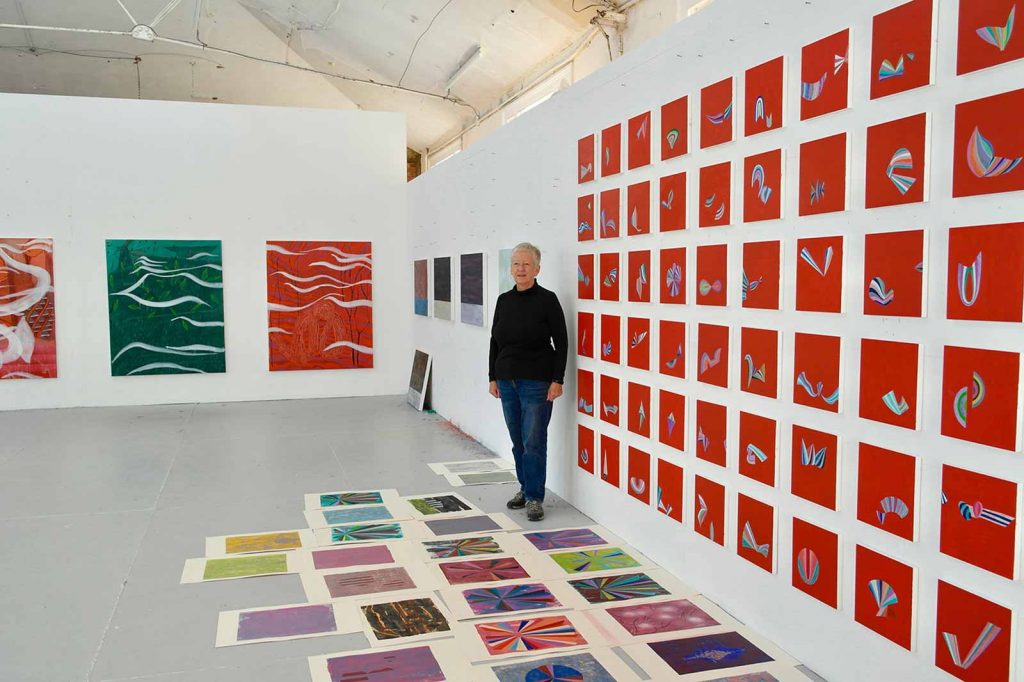
CBP: The building blocks that make up your paintings depict a wide range of figuration, referencing for example, iconography of natural forms, diagrams and the histories of painting. Some of the imagery appears tribal, like ‘Song of Malika’ and there is an allusion to textiles in works such as ‘Lament’ 2019. Can you talk about the development of this repertoire you’ve built up over the years, do you find yourself returning to motifs from older works?
Freya Purdue: This is deep question that addresses the core of my practice. I have always been a collector of images and visual sensual experiences. When I was a student I realised that by collecting together the images that I liked and combining them with memories of experience, I could explore my inner most ideas and perceptions using my visual imagination. This for me, proved to be way I could best work with my ideas and emotions to make paintings. Of course as a student it was only the beginning of a lifelong quest. The practicalities of connecting the actuality of being a human being and living in an amazing world with the long histories of humankind invokes many wonderful and inspirational ideas both inner and outer.
I am fascinated by many things relating to being a human being, besides the amazing power of thinking and the senses of the body there is the accumulated collective consciousness of the human race. The interior abilities particularly of sensitivity and empathy which stretch our consciousness in so many directions reach out from age to age binding us together across the aeons of time.
From the beginning of human life on this earth there has been the desire to express inner vision in some way through the different arts of making images and artefacts. My interest is especially with painting and the making artefacts that express the magic and power of that vision. From the prophetesses and visionaries and the shamanic practices of men and the medicine women of the past to the those practicing today in whatever form either in the tradition fields with one foot in the past or those in scientific frontline.
There is, as I see it, such a repertoire of potential to all of us that there is no limit to what types of energy can be put into painting.
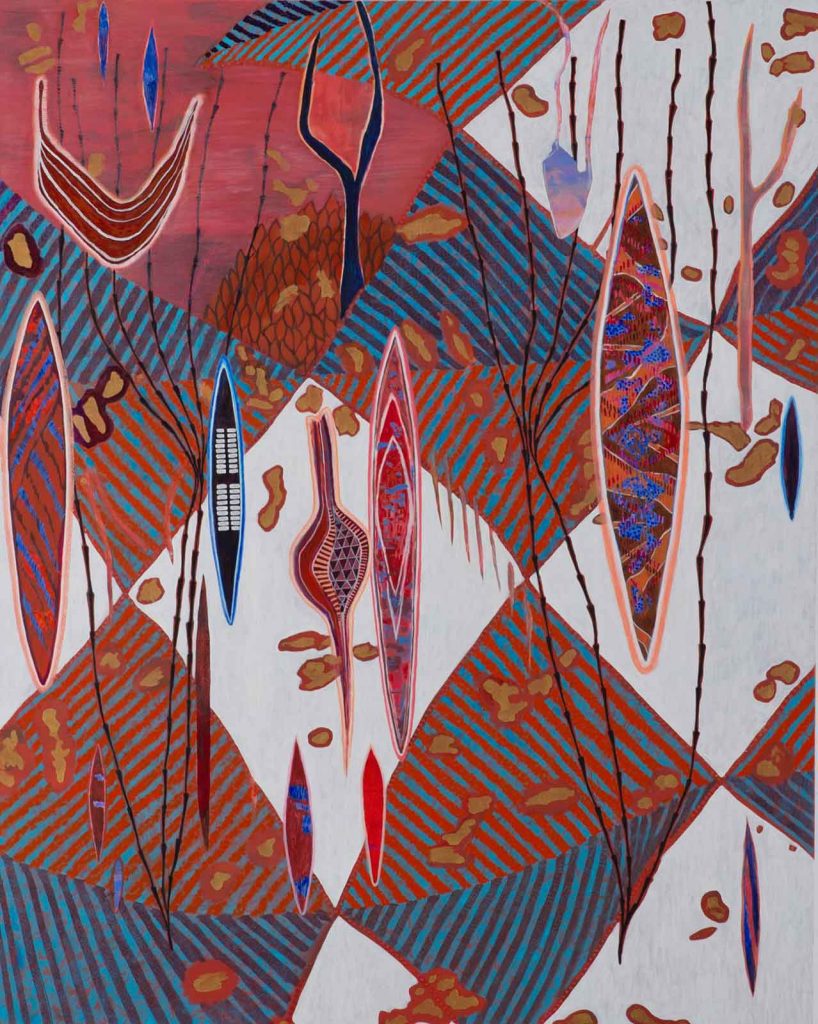
CBP: Are you influenced by an awareness of the evolving visual environments, such as digital textures?
FP: One cannot but engage to some degree the with evolving visual and scientific environment as this has really changed the way we see and experience so many things. One cannot imagine how grey and colourless things used to be before, you have only have to look at an old book of paintings or images to see what I mean. We just have so much bright colour all around us today in everything we look at!
I do make use of digital techniques in a number of ways but image collection plays a big part in that. I would have to say that it depends on what I am researching and how I need to bring ideas together that determines its use.
Today we have so much instant access to so many wonderful painters and makers of every kind from all over the world. I am discovering so much along with new artists almost every day and some over 100 years old like Carmen Herrera. This is so inspiring!
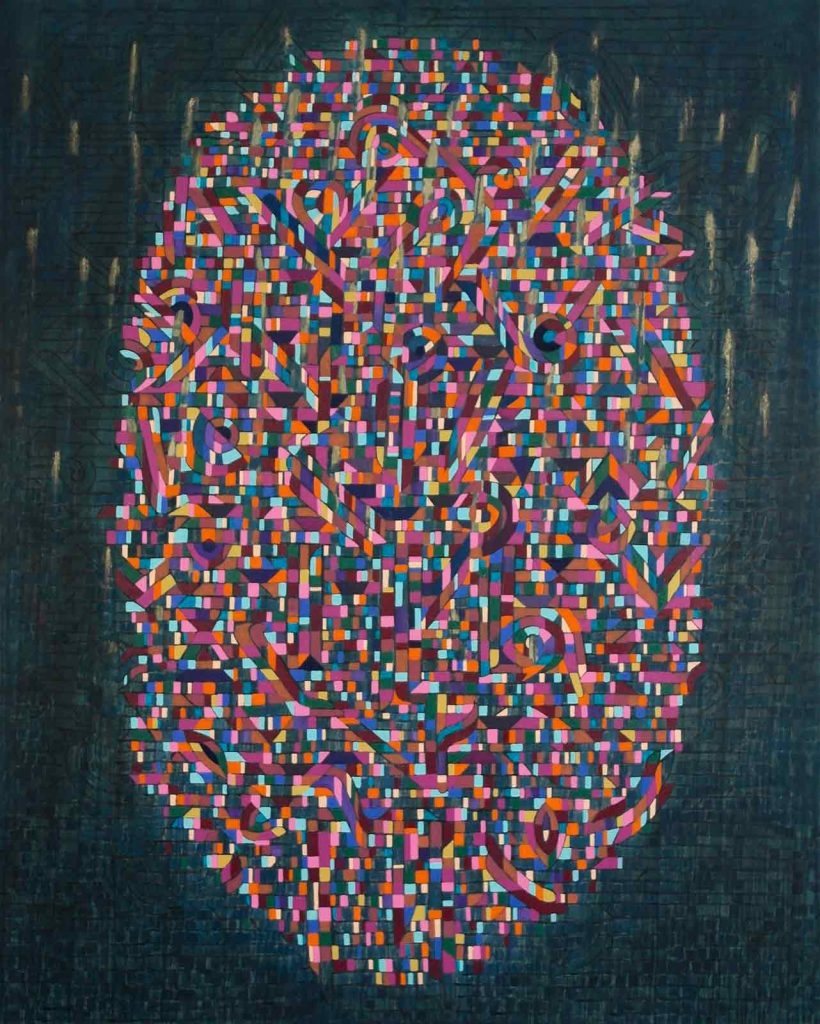
CBP: You’ve mentioned the importance of colour in energizing the painting and you’ve had some distinguished tutors who use colour strikingly like John Hoyland. Its integral to the construction of space in the works. How much is it predetermined, referencing particular colours from your sources of research, or do you work instinctively, putting on an initial colour ground and working outwards in response to that?
FP: I was lucky to study painting in 1978 – 81 at St Martins and Chelsea, in London, at a time when there were still painting schools and there was a massive energy in critical discussions about the formal methods of constructing paintings and the use of colour. There was always plenty of time to make paintings and a decent amount of studio space in which to do so. As far as influences are concerned; well I was very fortunate to have the chance to talk to many wonderful artists. I would also have to say that I learned even more by being a lecturer in painting myself at Chelsea over the years.
I think colour remains the most difficult tool for the painter and I still think it takes time know how to use it well. As a lifelong student of colour I am still learning.
I often use colour washes as a starting point for my paintings, these are usually determined by the subject of the painting. I don’t like to have too much white canvas as I start a new painting so a wash can be a direct line into the painting.
As far as my working practice is concerned it depends on the idea I have for the work that determines how I start a painting.
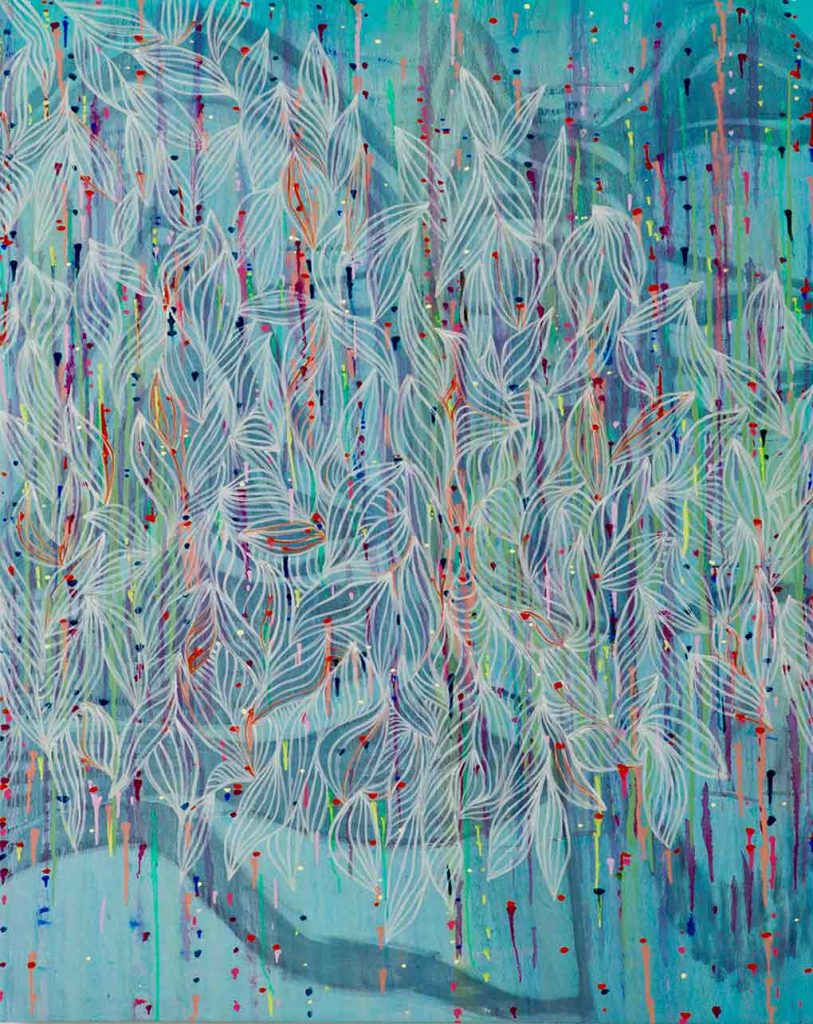
CBP: Do you use preparatory studies or drawings for your works? Either as a starting point, or to problem solve during the making of the work?
FP: I don’t usually make preparatory drawings as such because as my ideas come in a very visual form so I am able just get going on a new canvas. Sometimes I make small drawings but they are just in note form so I don’t usually use them to problem solve as such.
My starting point is sometimes an unusual or symbolic word or name or an idea that has come from discoveries made from my reading or my own visual world or by others such as scientists or doctors, that I have read about. I am always looking for something new that I haven’t encountered before. I have always been fascinated by the capacity of the human beings to explore inner and outer worlds work with energy towards new discoveries.
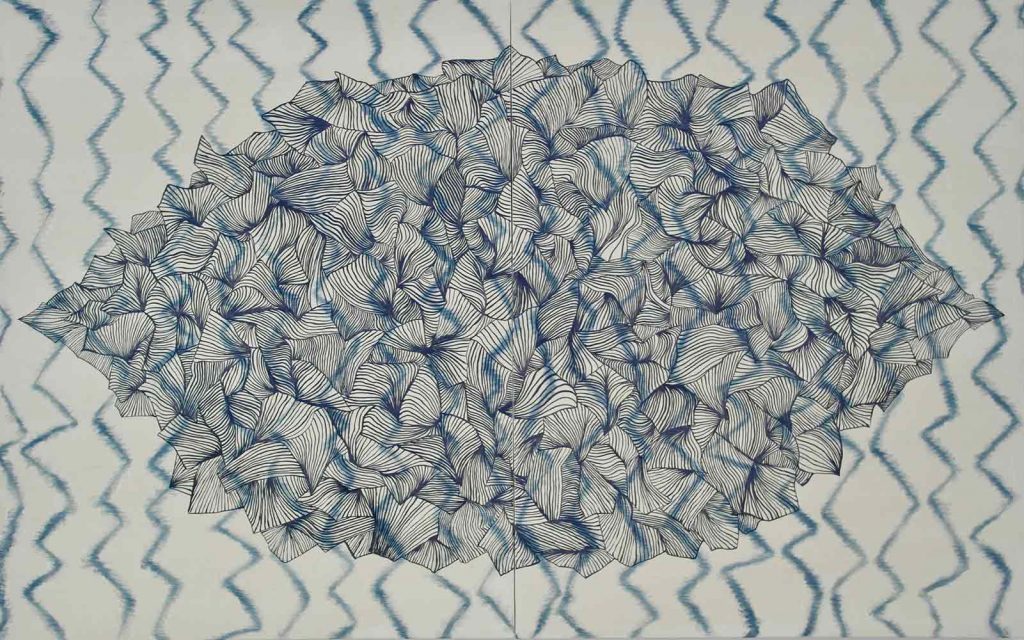
CBP: One impressive aspect of your practice is the individual identity of each painting. They can appear dynamically in contrast to a work painted in the same period, each their own entity. In exhibition they talk to each other but are self-contained worlds not necessarily as a series. When you’re working on a painting in the studio do you work with other paintings in the periphery of your vision, perhaps turning attention to them, or do you turn them around to focus entirely on the one you’re working on?
FP: Each painting for me has to provide the opportunity for a discovery of new energy or form. So the nature of my intention and the identity of each work is due to my desire to explore a particular idea that has arisen in my research. There is an intangible quality about the identity of an unexpressed idea.
Once I have tuned into the idea, creating a painting is a process of selecting the right methods of applying paint and the right colours etc to create something that can only be expressed using a visual language. It is an extremely rewarding thing to do, the poetry of which is a vital part of the work.
As I have said I am looking for something I haven’t seen or felt before. I want each painting to be an entity as you say and to have its own kind of power. Each painting has its own set of references and it own magical elements and these can take a while to clarify and fuse into the final work.
I am always thrilled to be starting new work so I do have a number of canvases on the go at any one time, sometimes they are connected by a theme and sometimes they are just waiting for me to find their visual element or solution. So this means that some work can take several years before I can sort out it completion.
I occasionally work on a series of paintings with a particular theme as a method to get things moving but only really tend focus on one at a time so some get left behind or put aside because they don’t belong in the series. The ‘Lament’ paintings were an exception they just came together and were made relatively quickly as a set of 5 paintings.

CBP: You mention in other interviews that some paintings are completed in a short period, weeks, others returned to over one or two years. Do these longer durational paintings change course of direction when you return to them to include new influences, and do you sometimes a forget the train of thought or idea that you started with? Have you exhibited work and then returned to work on it afterwards?
FP: Each painting seems to command its own energy and life force. Occasionally the idea for a painting is clear and simple so its completion is straightforward and all I have to do is follow my idea through. Sometimes a painting can become a real puzzle in which its becomes difficult to make decisions and I have to be patient until I can see the way forward for it. I don’t lose track of its direction but as I said it may have to wait sometime until I can see a solution to the visual problems it is beset with. I try not to over work my paintings because I want them to look fresh and alive.
I don’t return to work once completed.
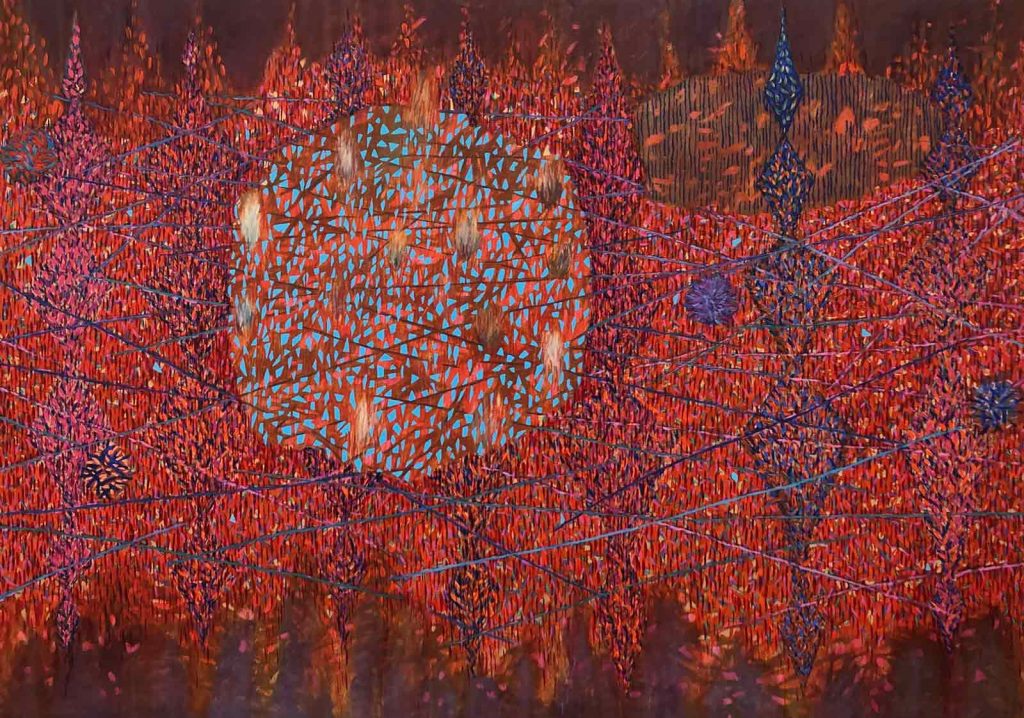
CBP: With the wide range of sources that feed into your work, from scientific to philosophical thought, can you discuss the influences on one particular painting, if we take for example the recently completed installation ‘Red Botanicals’ 2020, the singular figurative motifs appear more specific. Are the references set at the start, or do they enter the work during the course of the making of the work, sometimes in retrospect?
FP: This set of work “Red Botanicals” is yet to be completed. It had been in my thoughts for a year or so before I started it. I have said above that I don’t really make drawings for the paintings but in this case it was an exception, I had about 80 small drawings about 5 cm square prepared before I started. Each shape is different and the coloured stripes are mixed up individually for each panel. It’s taking a long time to finish because I am doing it in oil paint and each colour has to dry before I can put the next one on and it got a bit tedious. So I think it would have been better in acrylic paint but I always have a bit of difficulty getting my head round using that medium coming from a traditional oil painting background.
It will be shown in September 2021 at the Quay arts in my solo show that was postponed this year because of the pandemic.
The interesting thing for me is that this piece links back and extends work I was doing in the 90’s using both in 3D as well as 2D forms of work. I spent a lot of time making simple images of one colour on coloured grounds. Its made me want to make more 3D forms again as I do enjoy seeing this kind of object – I think I would need to organise some help to make them.
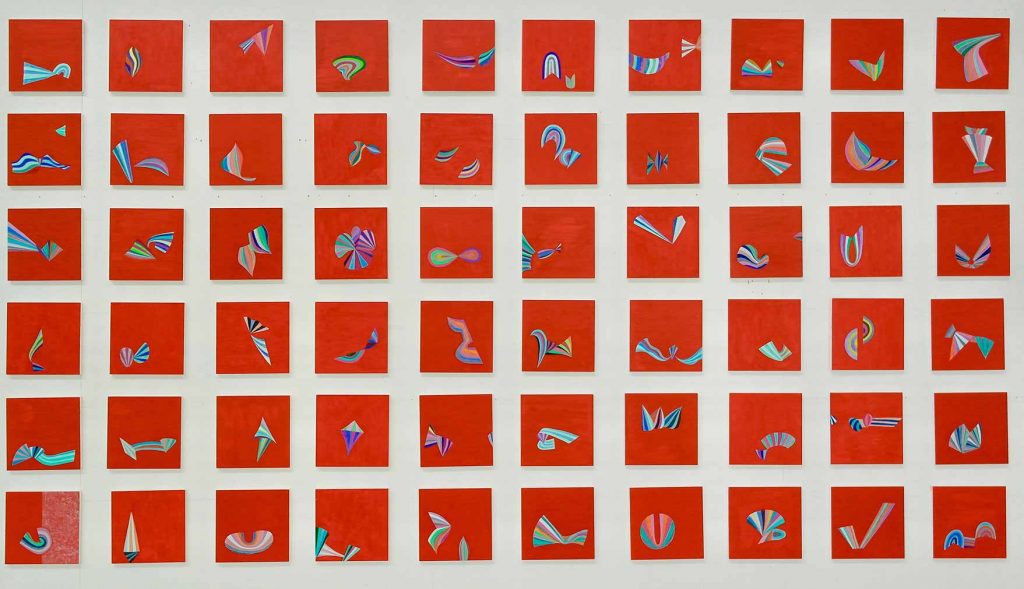
CBP: What is your studio routine at the moment? I know that you’ve had a major solo exhibition ‘Murmurs of the Wild River’ postponed due to Covid-19 restrictions. Are you continuing to work towards it?
FP: My studio routine is mostly working 4 days a week. I am continuing with my paintings and have completed a few so maybe some of these will be included in the show. I will decide what will go into the show next year as the title of the show was intended to be a kind of poetic embrace of my whole approach to making work.
At the moment I am working on a set of 5 new paintings based on a fast disappearing belief system in Ruanda. These have a link to the spirit of my painting ‘Song of Malika’ painting, so I am enjoying my meditations on this subject at the moment.
Finally I have also taken the opportunity during this time to work on a group of works on paper, part printed, part painted. This has been very productive process in moving ideas along more quickly whilst enjoying the materiality of the printing mixtures and potions I am making up and the exploration of visual solutions that have appeared through this process.
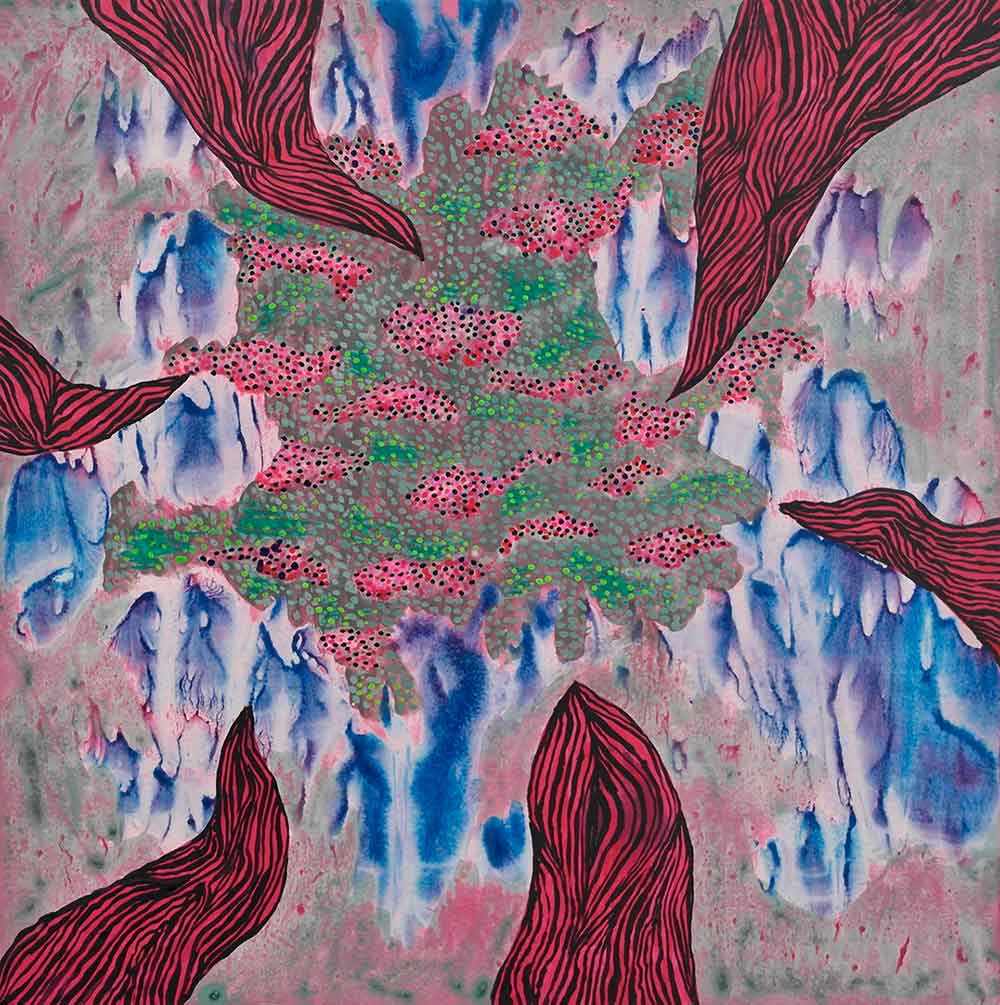
Freya Purdue lives and works in Ryde, Isle of White. Recent exhibitions include ‘Freya Purdue at the Edge’, solo show at Yellow Edge Gallery, Gosport 2019, ‘Mountan Size’ at Black Pineapple Contemporary Art Space, Middlesbrough 2019, ‘Made in Britain’, Priseman Seabrook Collection, National Gallery of Poland, Gdansk 2019, ‘Ennui’ Paintings by Freya Purdue & Marius von Brasch, APT Gallery, London 2019, Freya was a senior lecturer at Chelsea College of Art from 1983-2007 and has work in several collections in the UK and Chicago. Her forthcoming touring solo show is ‘Murmurs in the Wild River’ at Quay Arts Centre, Newport, Isle of Wight and The New Cut, Halesworth, Suffolk.
Links:
Exploring Timelessness with Painter Freya Purdue
Painting Today Podcast 13. Ennui Refigured: Freya Purdue



